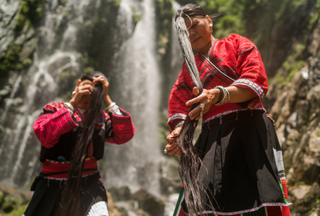Hair is significant in every culture around the world. It reflects our identity, allows self-expression, and ties us to our culture. Each culture has developed its own unique hair rituals, which are worthy of celebration. Although we sadly can’t highlight every culture in one post, here are 5 of the most amazing hair rituals from around the globe.
Otjize
The women of the Himba tribe in Namibia are known for the otjize they apply to their hair and skin. This red pigment is made by combining animal fat, resin, and ochre. Since water is in short supply, Himba women developed otjize to both beautify and protect their hair from the harsh sun. In addition to adding otjize, women often increase the length of their hair by weaving in goat hair and hay. The hairstyles both men and women wear are also symbolic, communicating age, marital status, and rank.
Hair Oiling
For Indian women, hair oiling is a time-honored ritual. Following traditional Ayurvedic practices, women massage natural oils infused with herbs into their hair. Hair rituals are also important for bonding, with mothers passing the traditions on to their daughters. Stories are told while the oils are mixed, and mothers massage the oils into their daughters’ hair. Hair oiling is said to restore moisture, increase shine, and aid in growth, while also being a relaxing and even meditative experience.
Blow-outs, Velaterapia, and More
In Brazil, beauty is so prized that the government recognizes the “right to be beautiful” for their citizens, even subsidizing plastic surgery at public hospitals. As you can imagine, the demand for gorgeous hair is intense, and many hair rituals have developed in response. You’re probably familiar with the Brazilian blow-out, which was, of course, developed in Brazil. Brazilians also turn to keratin treatments on a regular basis. However, many Brazilians also employ more traditional methods in caring for their hair. For example, split ends are burned off with the flame of a candle (velaterapia), and some women straighten their hair by pinning it to their heads and wearing a stocking over it while they sleep.
Braids
In Native American cultures, hair is a core tenet of identity. In many tribes, hair is only cut after a significant life change or loss. Throwing cut hair away is considered disrespectful. It is ceremonially burned or buried instead. For Native Americans who were subjected to forced assimilation, the loss of their hair was devastating. Now, many Native Americans are striving to restore their traditional hair rituals, including wearing traditional braids and adornments. Hair is considered sacred, and the braids represent the strength and connection of the tribe. Family members often brush and braid one another’s hair, but it is considered disrespectful to touch someone’s hair without permission.
Rice Water
Naturally, we couldn’t end this list without highlighting a hair ritual that’s near and dear to our hearts. The women of the Red Yao tribe appear in the Guinness Book of World Records for the longest hair village. And they credit that incredible length to their ritual of washing their tresses with Longsheng rice water–the same Longsheng rice water that appears in every bar of Viori. Red Yao women only cut their hair once in their lives to signify that they are ready to marry. Yet their hair stays long and healthy throughout their life.
We were honored to be tutored by the Red Yao and continue to give back to the tribe through our Beautiful Reason Initiatives. Learn more about Viori’s efforts to help the Red Yao here.

